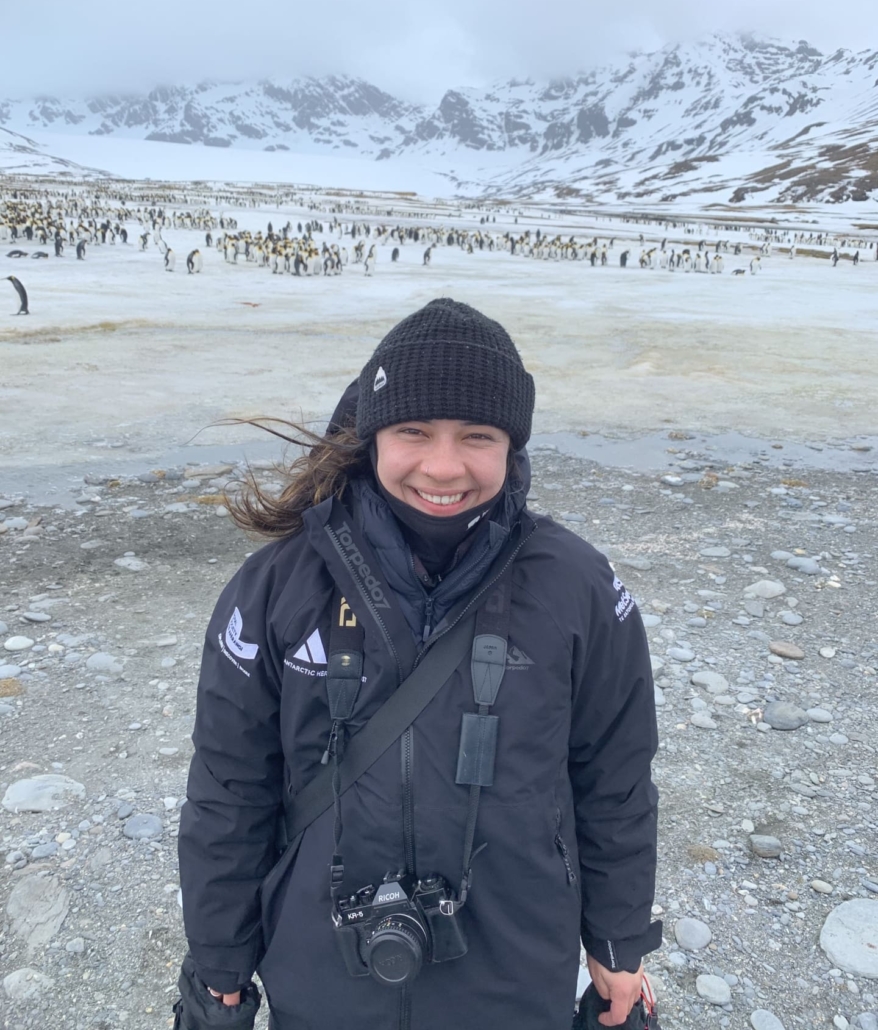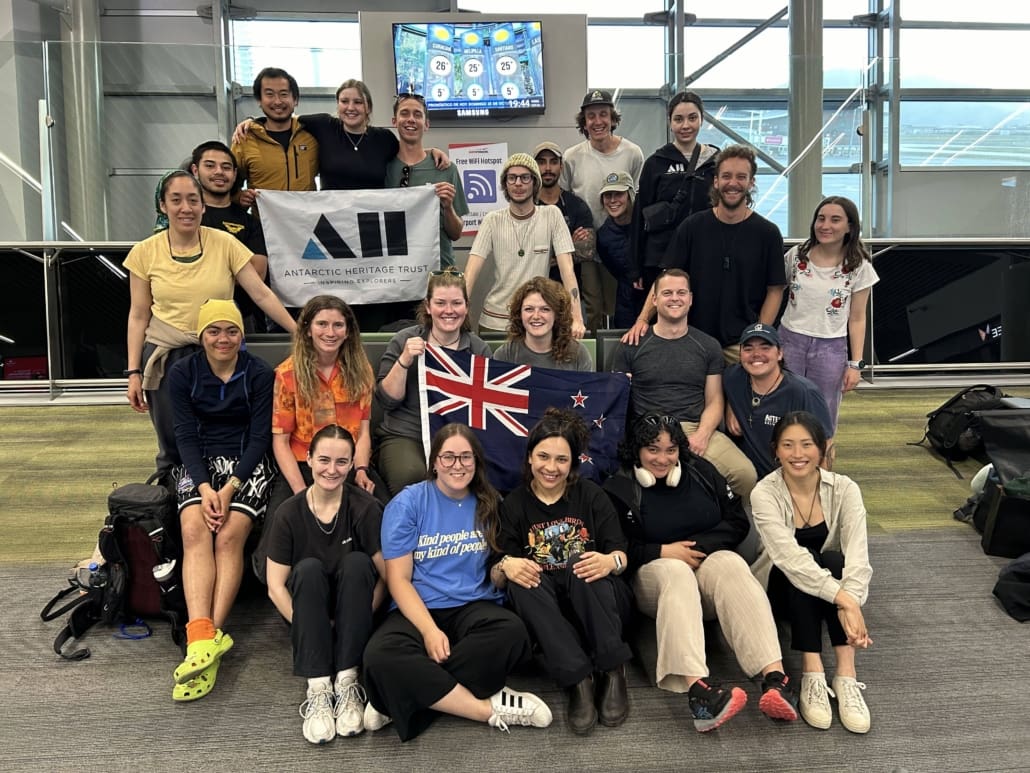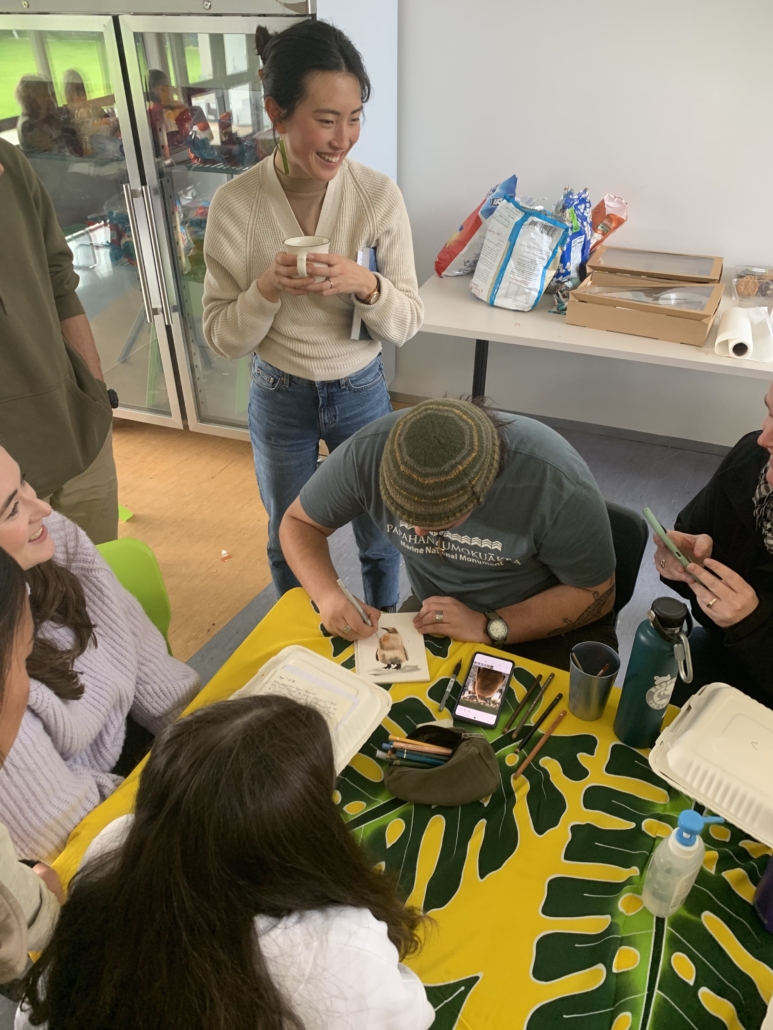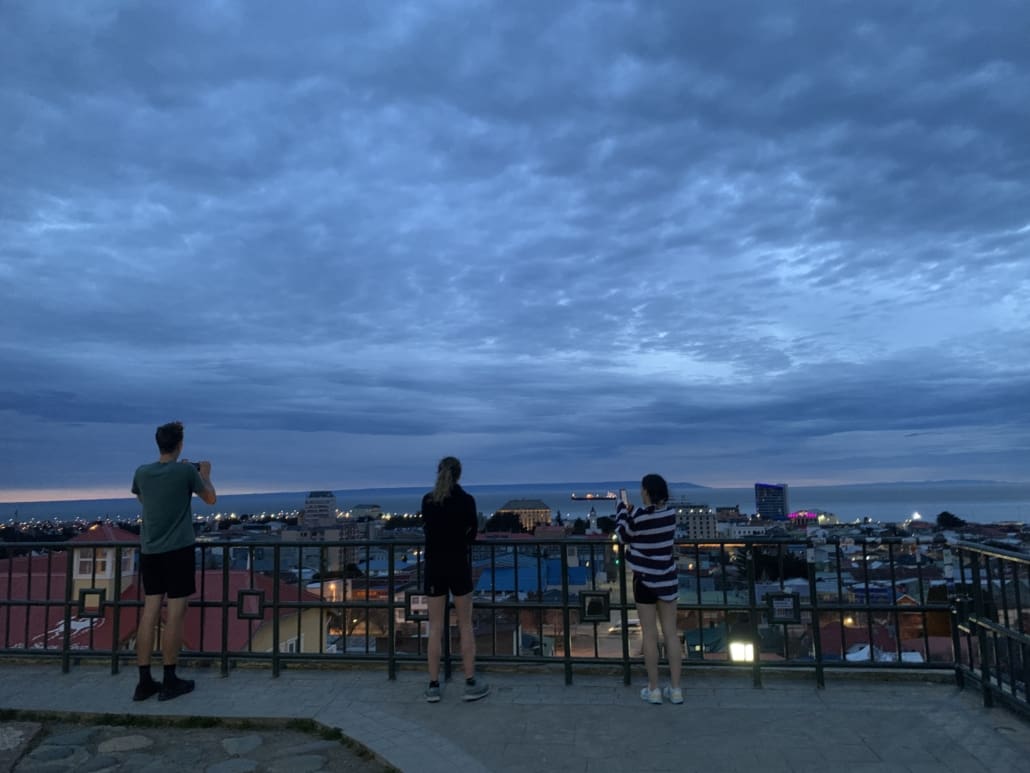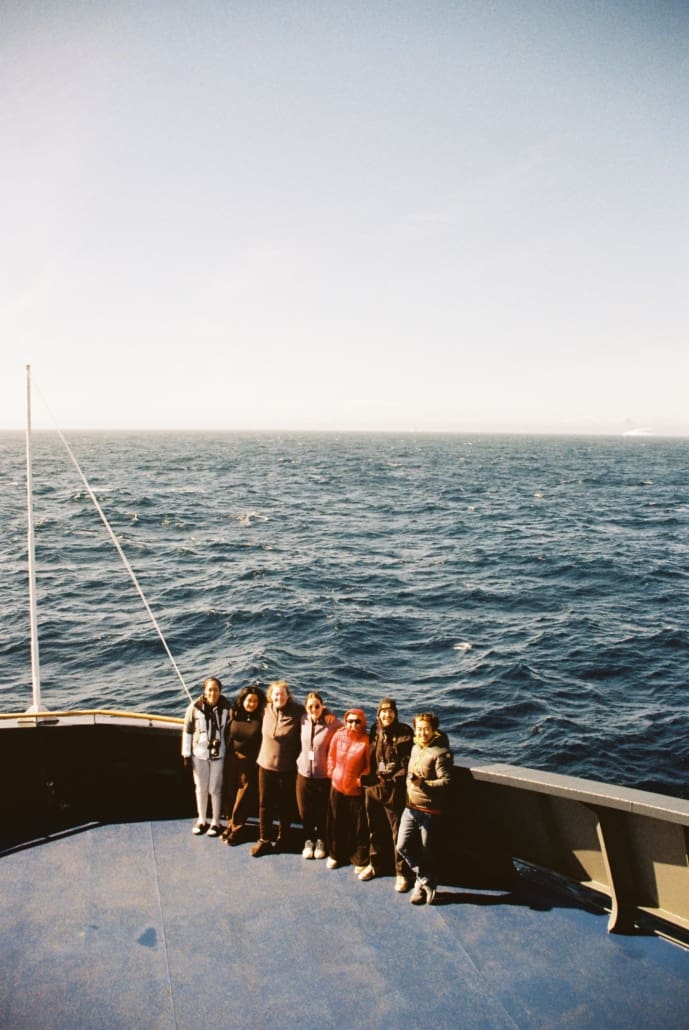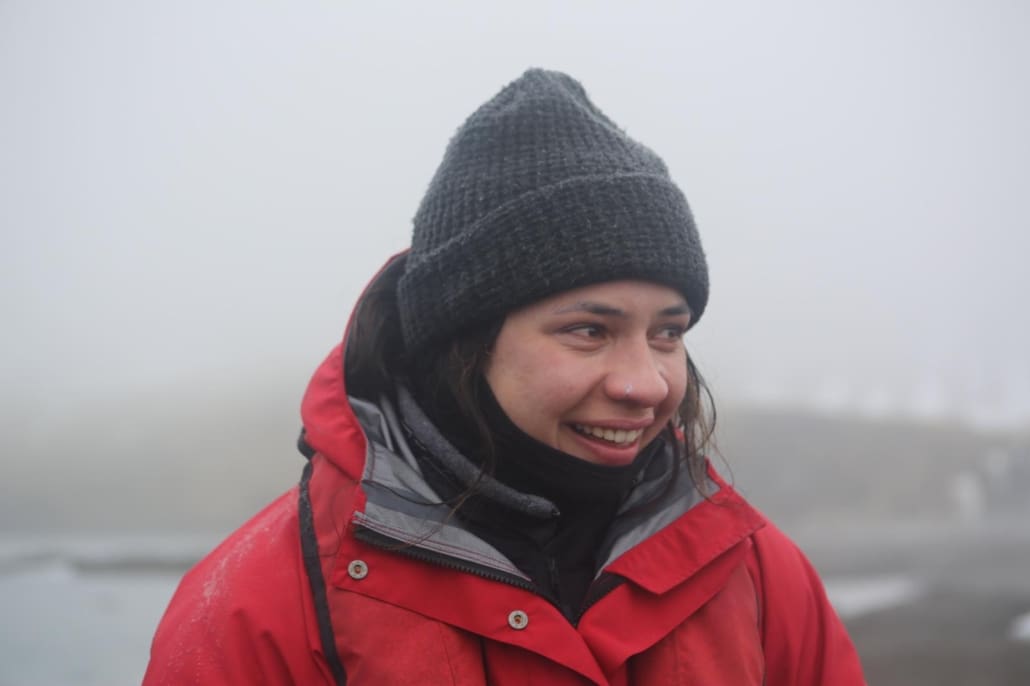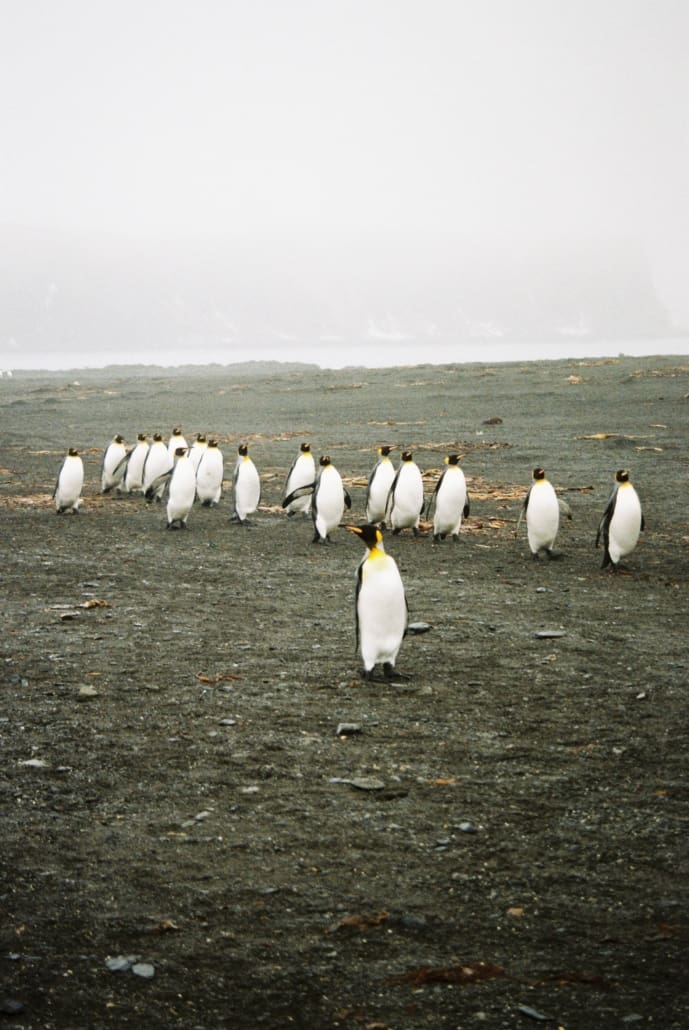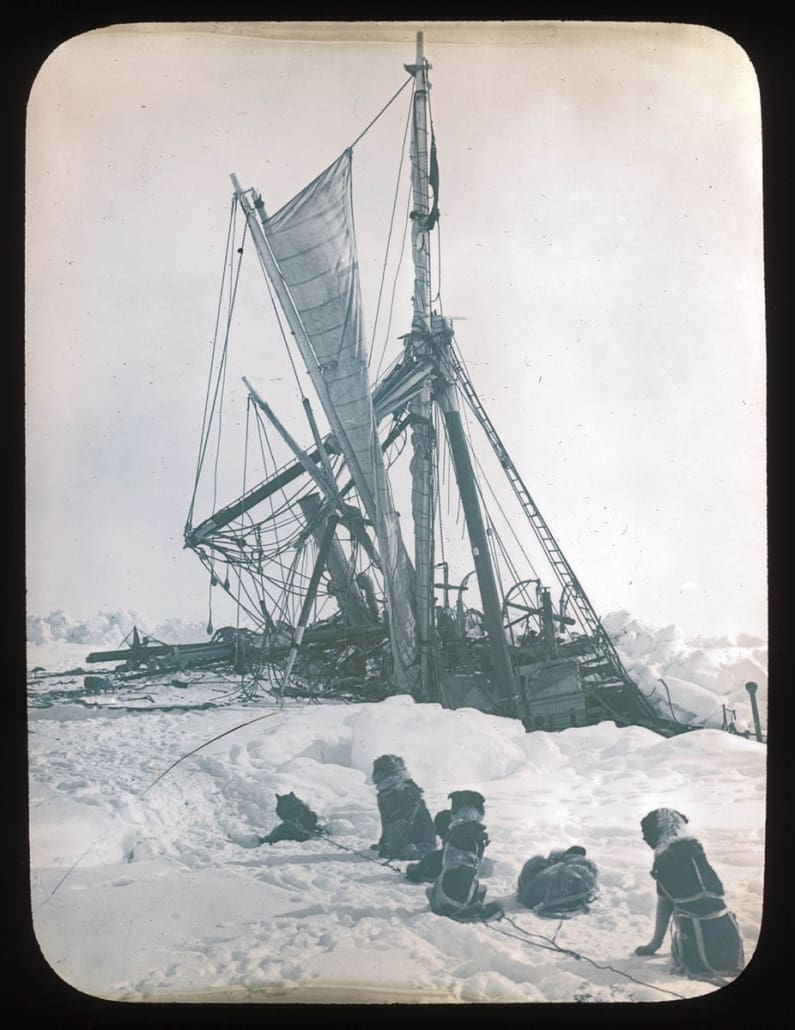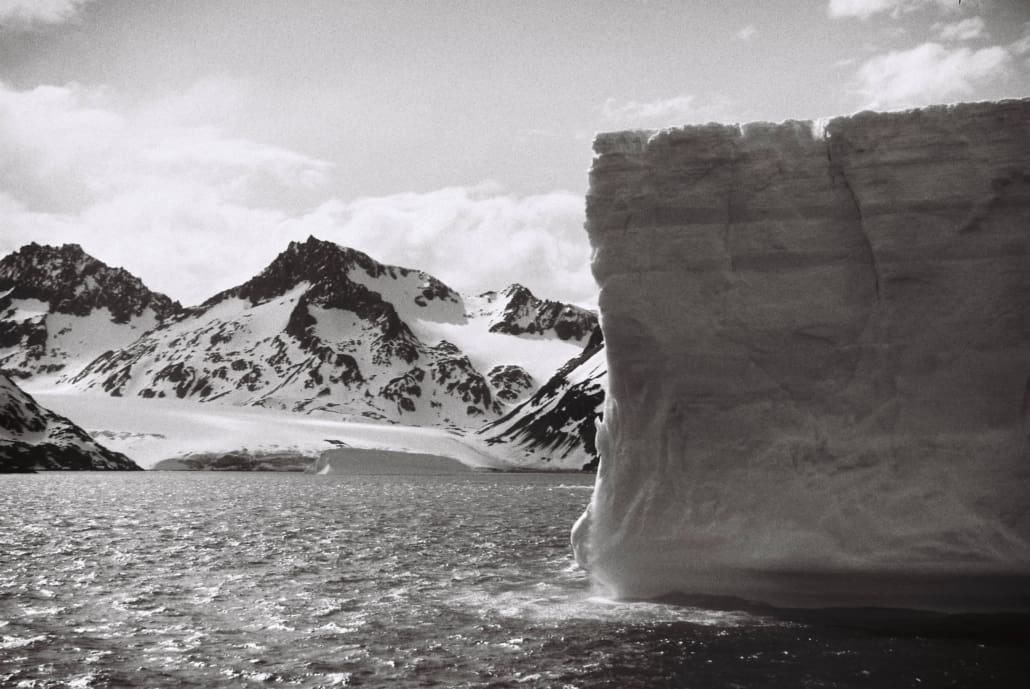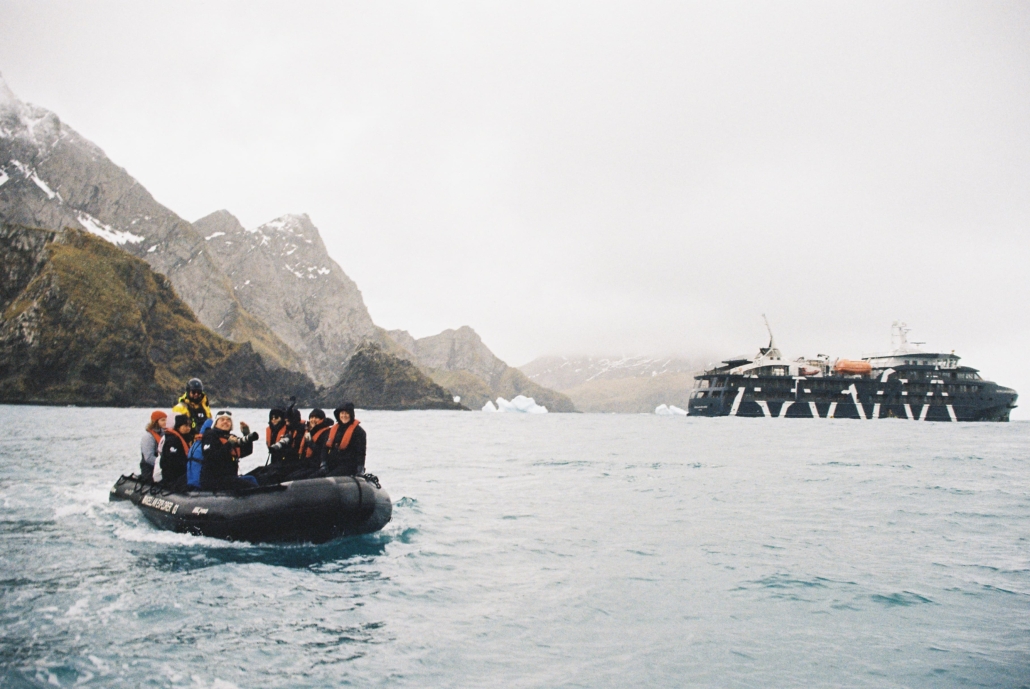Expedition Blog – Tegan Allpress, South Georgia 2023
Big smiles at St Andrews Bay. © AHT/Kaitlyn Martin
Tegan Allpress was one of 22 young New Zealanders who travelled with the Trust to South Georgia in October 2023 for our ninth Inspiring Explorers Expedition™ to honour the centenary year of Sir Ernest Shackleton’s final expedition, the ‘Quest’.
On Tuesday 17 October 2023, at around 5am, our plane from Santiago, Chile landed back on the tarmac at Auckland International Airport, marking the end of our expedition to South Georgia. Sleepy-eyed, some of us managed to catch more z’s than others. We hugged each other goodbye in the terminal and trickled off to our own little pockets of Aotearoa. Some had whānau waiting to pick them up in Auckland, some peeled off quickly to catch connecting flights, and some of us unlucky (or lucky) ones had a later flight, giving us more time to make the most of each other’s company. After a few hours, and a few delayed boarding announcements, I boarded my flight back to Tahuna, Queenstown, returning home forever changed, with a life-altering journey under my belt.
The Inspiring Explorers Expedition™ team waiting for our plane home from Santiago, Chile. © AHT/Anna Clare
Like many on my team, I hadn’t heard of South Georgia Island until I came across the application for this expedition. I was scrolling down my Facebook when I saw an ad from a friend with the title something along the lines of “Are you a New Zealander aged between 18 – 30 with a passion for adventure and exploration and interested in going to a remote island?” It didn’t take much convincing for me to submit my application. After a month or two of nerve-wracking anticipation, including the world’s most exciting interview with Antarctic Heritage Trust staff Mike Barber, Anna Clare, and Tedi Robinson, I got the call from Mike, and preparation for our expedition began.
The first time our team of 22 met was in June 2023, roughly 100 days before our departure, at our team-building weekend. At this point, we had no idea of the friendships and lifelong connections we would forge. This whirlwind weekend marked the start of our adventure, where we discovered who the people were we would be sharing this experience with and learned many exciting details about the expedition. Before this point, the expedition was an intriguing mystery to me, and to be honest, as much as we prepared and heard about the place we were going, the boat we were going to be travelling on, and the projects we would be working on, the reality of our expedition didn’t really sink in until we first stepped foot on South Georgia Island.
At team building weekend – our first time discovering Charlie Thomas’ incredible painting talents. © AHT/Tegan Allpress
Inspiring Explorers Henry Conquer, Kelly Davenport and Rose Lasham admiring the sunrise over Punta Arenas on one of our runs. © AHT/Tegan Allpress
The journey up to this point had been magical in itself. My parents had been through Chile and Punta Arenas in the 1990s, so I’ve always wanted to explore these places for myself. Being able to go there on our way to South Georgia was a treat. One of the highlights of the trip for me was spending time exploring Punta Arenas with fellow Inspiring Explorer Kelly Davenport on our running excursions. There’s something so invigorating about doing an activity you do at home in a foreign place! The days leading up to our embarkation on the Magellan Explorer were spent in thought-provoking, hilarious, sometimes challenging, and critical (but equally educational) conversations with my new friends, the beginnings of some very special friendships. By the time we stepped foot on the ship for the first time, I was already full to the brim with memories. However, the feeling of seeing the ship and being acquainted with it and its talented crew is definitely one to be beaten!
During the next three days of open-sea travel, we were treated to an array of insightful presentations and lectures by the Antarctica21 guides and some of our AHT crew. We kept ourselves occupied by soaking up their expertise as well as spending time getting to know the 80 odd people we ventured with. We monitored our progress closely on the information screens that were dotted around the boat, inching closer and closer to the little ocean croissant that was waiting for us. After three nights sleeping on gently rolling seas and being awoken by the docile tones of our expedition manager Hadleigh’s voice, the day finally came!
It started with one of my highlights of the whole trip; setting eyes on our first icebergs (both incredible and jarring to witness) and then spotting South Georgia poking up from the clouds in the distance. As we voyaged closer to the island and entered a thick layer of cloud, the ship slowed and quieted, and a group of us bundled up and headed outside to take it all in. We knew we must’ve been close to the island, but due to the fog, we couldn’t see it. However, the presence of the land was felt all around us. In the distance, we spotted our very first raft of king penguins heading towards the land, and with that, our hearing sharpened, and we heard the first sounds of a rookery, a cacophony of squawks coming from the Right Whale Bay rookery of penguins. The next couple of hours were a flurry of excitement in preparation for our first landing on South Georgia. We donned our thermals and multiple layers of fleece, grabbed our waterproof bags and cameras, and headed down to the muck room to board the zodiacs for the first time. Even as we boarded, the fog was still thick enough that we couldn’t see the land. However, as we motored towards the island, South Georgia unfolded before our eyes.
South Georgia is about to appear in the distance. Inspiring Explorers (left to right) Te Aroha Devon, Destiny Martin, Kaitlyn Martin, Gemma Wyllie, Lily Green, Cole Yeoman and Sasha Cheng. ©AHT/Tegan Allpress
I can’t put into words the feeling that overcame me as I stepped foot on the beach of Right Whale Bay and was met by towering mountains, a black sand beach dotted with huge elephant seals, and thousands of king penguins waddling around. I broke down as soon as my feet hit the beach. One of the guides, Pablo, who became a friend to me, spotted how emotional I was and offered a reassuring hug as if he knew exactly how I was feeling. Upon getting home, I have reflected on this moment a lot and tried to figure out why I had this response. I think what hit me the hardest was the immense duty to South Georgia’s fragile environment and all its feathery, fluffy, and flubbery friends, as well as the responsibility to protect Te Taiao and to utilize the privilege of being able to visit such a remote place like this.
Emotions overcame me when I first set foot on Right Whale Bay. ©AHT/Rose Lasham
As we ventured further into our adventure, it became very clear why each one of our team had been selected. Not only did the AHT staff pick a group of humans who were passionate about exploration and honoring the generations of explorers wo came before us, but with our varying backgrounds and stories, each one of us has a unique perspective, set of skills, and voice to inspire others through our experience.
Our welcoming committee upon landing at Right Whale Bay. ©AHT/Tegan Allpress
I was honored to be placed in the Visual Arts outreach group, tasked with creating an exhibition of artworks from our expedition. In preparation for this expedition, I delved into the pioneers of Antarctic exploration photography and was inspired by the courage and determination of Frank Hurley, the photographer on board Shackleton’s Endurance voyage, whose dedication we have to thank for images like this.
As a photographer myself, I was brimming with excitement to take my cameras to South Georgia and tell my own story and perspective of it. In my practice, I am a photographer who primarily works in black and white film photography and have been interested in my Tūrangawaewae – my place to stand, and those places that make me feel connected and empowered. Throughout my university studies, I was not only navigating my way through leaving home for the first time but also navigating my way through losing both my parents in the space of 13 months. I leaned into my research and artistic practice as a way of making sense of my grief as well as using my photography to convey those emotions that words so often fell short of. After spending those four years at university so deeply rooted in rediscovering my Tūrangawaewae, my passion for photography began to wane, and I suffered from creative burnout. However, something shifted in me the day we found out our outreach project, and a new artistic seed was planted. Stepping foot on South Georgia for the first time and breathing in this environment was exactly the watering that that seed needed to bloom. Not only did I feel connected and empowered by this place, but it reignited my love of storytelling through my photos.
The ‘Endurance’ after it was crushed by the ice, shown with the expedition’s dogs, 1914-1917, Frank Hurley.
From the collections of the Mitchell Library, State Library of New South Wales.
The seven days we spent on the island left me in an emotional whirlwind, grappling with the question of how I can make a positive impact on this special place. It was fascinating to me that a lot of the emotions I was encountering on South Georgia were reminiscent of grief. Grief is a familiar beast that has reared its head in a myriad of ways throughout my life. Grief, for me, has always been the acknowledgment of a profound loss. Here on this remote Island, I recognised those feelings again when I laid my eyes upon fragments of the A76 iceberg, knowing that their origin was the Ronne Ice Shelf of Antarctica. Perhaps that grief lay in the fact that this remote island is in the throes of being so violently affected by climate change, or perhaps it was that I felt so connected here, and I know that this opportunity to experience this place may never happen again. As I did in university, my camera became my way of making sense of it all. Through my viewfinder, I began to piece together the elements of my experience; the icebergs, the wildlife, the untouched landscapes, each shot a tale of the island’s unparalleled beauty and the looming threat that it faces. My hope is that these images transcend the visual, carrying the weight of the all-encompassing experience and the environmental responsibility that binds us all.
Drygalski Fiord, October 2023. © AHT/Tegan Allpress
At our team-building weekend, Trust Board Member, Georgie Archibald (Inspiring Explorer from a 2019 Trust expedition and a genuine legend) mentioned to us how difficult it may be to transition back into “real life” after such an experience. This didn’t really hit home to me until the point in our trip we were “turning back” and starting our journey back to the Falkland Islands from our southernmost excursion in Drygalski Fiord. Our minds had just been blown by the grandeur of the fiord and the Risting Glacier, and as we were motoring out of the fiord into the open ocean around South Georgia, I stood at the bow of the ship with my friend Kaitlyn Martin, in a comfortable silence. Neither of us spoke much, but we both knew we were feeling the same thing, a deep sadness of leaving this place and the beginnings of the end of our expedition. In a moment of almost cinematic timing, a raft of king penguins arose next to our ship as if to say goodbye too. I shared a few conversations with my friends about how on Earth we were ever going to be able to recount or convey just how special our trip was. After much discussion, we realised that we may never be able to fully articulate just how much this trip means to us all but how special and how privileged we are to have experienced a place like South Georgia with a group of people as special as we did.
Some of our crew on our last excursion in Elsehul, the Magellan Explorer perched in the background. © AHT/Tegan Allpress
South Georgia Island has not only profoundly changed my photography practice, but it’s changed the way I connect with Te Taiao. I heard the call of our precious planet so loud and clear in South Georgia; we must do better, we must protect the voiceless. South Georgia, with its icy grandeur and vulnerable beauty, became a reflection of the delicate balance of our planet. As I sit with my images now, I am reminded not only of the ephemeral nature of my time on this island but also of the urgent need to preserve such places. In my photos lies a call to action, a plea to recognise our shared responsibility in protecting the precious wonders of our world. The immense privilege of being able to experience such a remote place like South Georgia will remain in the fabric of my being for the rest of my life. I want to extend the deepest thanks to the Antarctic Heritage Trust, MetService, Royal Society Te Apārangi, and the generous donors to the Inspiring Explorers™ Fund for this opportunity.

